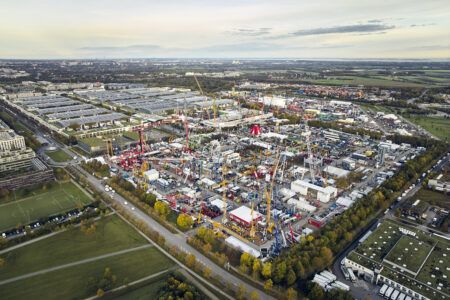A digital revolution in the construction industry could dramatically increase productivity and save billions of pounds, while radically reducing disruption to the public and slashing the number of fatal building site accidents.
That was the rallying call to the sector today from Highways England as it spearheaded the launch of a 15-year plan to accelerate the use of technology in infrastructure. Connected and autonomous plant (CAP) is already being used to transform activities across the UK construction sector, including for example the use of robotic trucks on Britain’s biggest road project, the recently opened A14 improvement.
It has been estimated productivity improvements including the use of driver-less machines on site could boost productivity by £400bn by 2040, while slashing accident rates. Now the government company, with partners TRL and the Infrastructure Industry Innovation Partnership (i3P), has set out a roadmap – a vision where the use of CAP techniques will become standard industry practice by 2035.
Highways England chief executive Jim O’Sullivan said, “Connected and autonomous plant will make work safer and quicker. The Roadmap lays out the benefits and addresses the barriers to making this a reality. We are confident the Roadmap will help our supply chain to rapidly make this the norm on our worksites.”
The CAP Roadmap was developed through collaboration with more than 100 industry stakeholders. It predicts that adoption of this technology across the construction sector could:
- Reduce fatalities in the construction sector by 37%
- Improve productivity by up to £400Bn by 2040
- See annual savings of £53bn across new construction work
- Assist with 47% of construction activities currently performed
- See road construction deliver benefits of >£3bn between now and 2035
Mark Thurston, CEO of HS2 remarked, “This work charts an extremely exciting and potentially game changing route as to how we operate our sites as we build Britain. My challenge to our industry is to take the steps we can take today to improve our future, moving forwards together to make our people more efficient, and safer than ever.”
The roadmap sets out nine workstreams focussing on key areas. Alex Wright, chief technologist for TRL explained, “The CAP roadmap has been developed collaboratively with more than 75 organisations. Through a wide variety of questionnaires and workshops, we identified the actions required to overcome the various technical, business and legislative challenges to delivering the vision. Overall, the Roadmap brings together nine pathways which have been identified to deliver success by 2035. This includes elements from legislation, regulation and policy as well as factors facilitating finance and investment and an understanding of the skills gaps.”
Highways England is already trialling CAP plant in key areas. Automated dump trucks were trialled on the recently-opened A14 Cambridge to Huntingdon improvement in the East of England.
The trucks were programmed remotely to follow a pre-determined route and have the capability to detect and avoid obstacles and other vehicles, along the routes as they drive.
They provide the potential for round-the-clock working, helping to reduce the length of time roadworks are on the ground. And by being automated they reduce the risk of road workers being involved in incidents on site, allowing jobs to be moved to other skilled areas.
On the A14 and on motorways, a robot is saving drivers from hundreds of hours of disruption. It uses precise positioning technology to mark out where white lines need to be painted on new or resurfaced roads and puts road workers at less risk of an accident.





